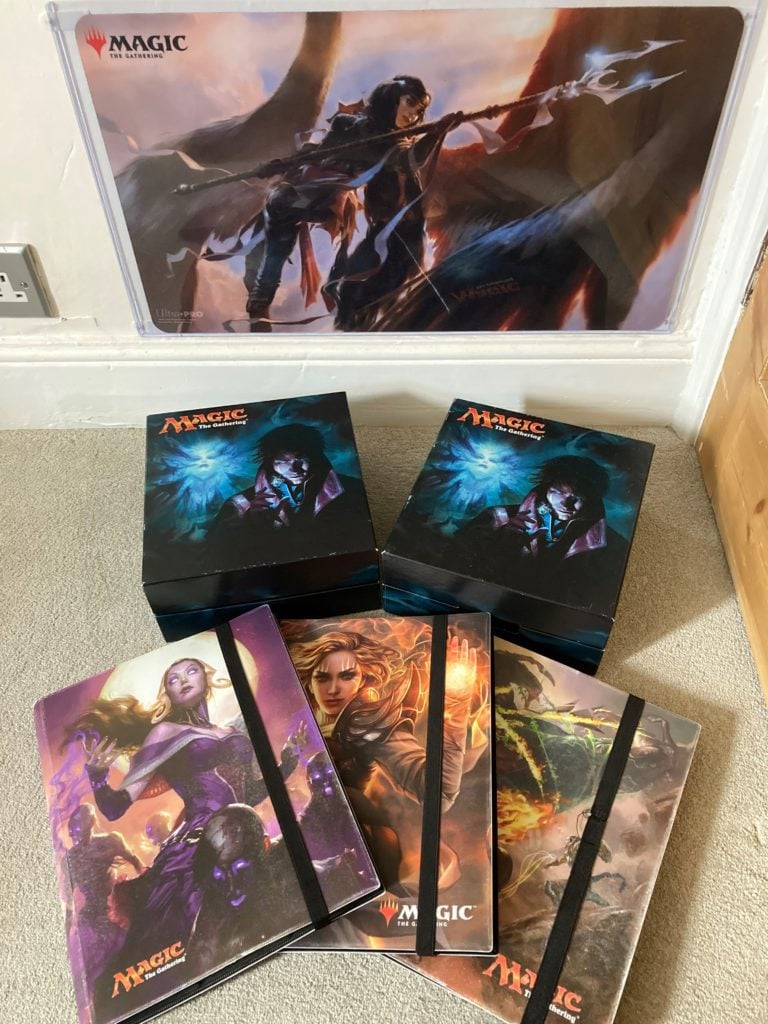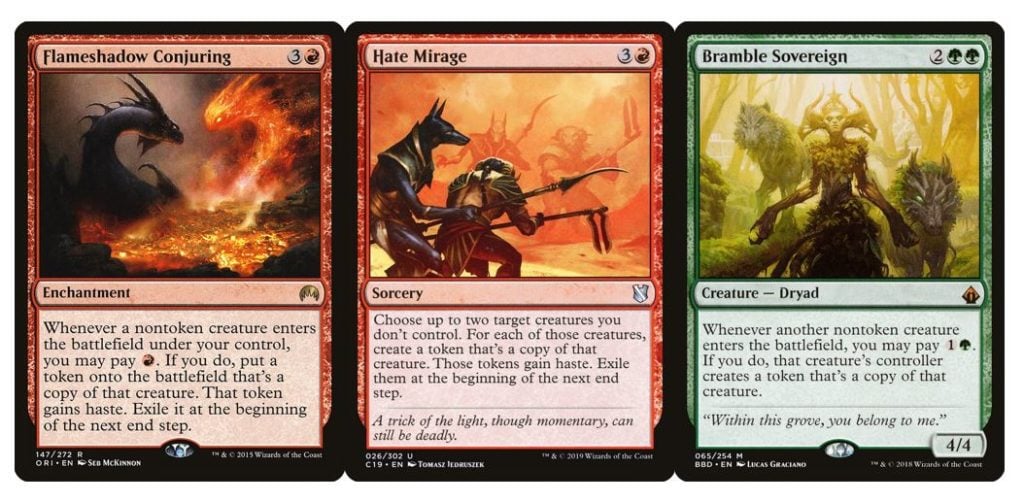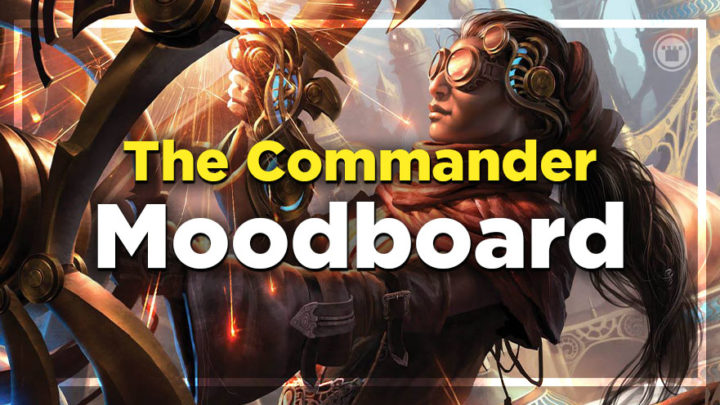Today, Kristen takes us through her deck building process. She uses an iterative process, usually offline, and kicks it off with her “Commander Moodboard”.
Deck building is often a very personal thing. No matter how we do it, and no matter what resources we use, it’s something very unique to each Commander player. I’ve often been asked how I build my decks, and for insight into the topic. I’ve talked about different aspects of that deck building before, like in my article for Hipsters about why you should try deck building offline.
As of yet, though, I’ve never really dug into my full process — so today seems as good a day as any to share it with you. It starts out with a little something called my Commander Moodboard.
Prior Planning
The Commander Moodboard is the stepping off point of my deck building journey, but before I put together my moodboard, I need crafting materials. Once I’ve decided what deck to build, my first stop is going through my collection to pull out the cards I think I might play in the deck.
There’s one main reason why I prefer to approach things this way, rather than going straight to a website like EDHRec: we’re in the discovery phase of deck building. At this stage, I have no idea what subthemes — if any — my final deck will use. I also don’t know if there are any niche or interesting pet cards that might find a home in my deck.
By using an online resource first, two things would happen. Firstly, I’d risk building a deck that (in my mind, at least) is too formulaic. I love to have a personal touch, and I’m also cognizant that the data on EDHRec isn’t always empirical. Sometimes a card is placed in a lot of lists because of a misunderstanding in synergy. A great example of this is cards with the exert mechanic being played in Wulfgar of Icewind Dale; Wulfgar’s ability doesn’t copy exert because exert isn’t triggered in the correct way.
More importantly, though, I’d end up robbing myself of the opportunity to hunt through my collection and piece together the puzzle. I personally really enjoy this stage of deck building, but I can see why others might not. It depends on what kind of player you are, with Explorers more likely to want to adopt this method.

For starters, it requires a fairly well sorted collection, and a collection that’s not too large. I limit myself to two gift boxes and three folders (plus my folder for promos and oddities, not pictured). I divide any valuable or foil cards into my three folders — creatures, spells, and artifacts/lands — and then divide the remainder of my cards over two gift boxes. One is WUBRG, and the other is gold/artifacts/lands. Part of the reason I limit myself to this space is to keep my collection relevant and in use; if I don’t use a card, there’s no reason for me to own a playset. It’s also pretty handy when I reanimate or steal a creature on Spelltable, because I can quickly flick to a copy!

Of course, as I said above, this method is only as good as the organizer of said collection. If you have piles of cards out from previous deck building sessions or deconstructed decks, then you’re going to end up missing cards in your journey. I know I’m not alone in questioning myself, late at night, “Just where is my third copy of Urabrask?!”

The beauty in this stage of deck building for me is in finding those hidden synergies. Did I play the Hate Mirage I picked out for Wulfgar? No, but it did lead me down an interesting avenue thinking about tokens. In the end, Delina, Wild Mage made the cut, but during the process, I’d begun to piece together thoughts on playing with Bramble Sovereign and Flameshadow Conjuring.

Something similar happened when I was considering upgrades for my Syr Gwyn deck recently. A few questioned whether I’d be playing Vorpal Sword, and in my mind, I’d already decided not to because of a lack of Swamps/Cabal Coffers. Once Mask of Griselbrand came out, I again had considerations about pivoting the deck. In the end, though, I decided to save both of those cards — and a Cranial Plating — for a Kels, Fight Fixer deck, featuring artifact tokens and the new Eloise, Nephalia Sleuth. I immediately identified Eloise for this deck in my Undead Unleashed precon upgrade article, and it’s because I’m always engaged in that discovery-focused mindset when it comes to deck building.
While those lines of thinking didn’t ultimately prove fruitful for the aforementioned decks, it did give me ideas for another deck, and another synergy I really want to try — and that’s the gold nugget you’ll find when deck building offline.
The Commander Moodboard

Commander Moodboard of Wulfgar of Icewind Dale. I need to cut a lot of cards here – and inevitably find a few more.
Enter the Commander Moodboard. Once I’ve gathered and pulled out the cards I’m interested in — which is usually way over 100 spells — I place them on a playmat to see exactly what I’m working with. At this stage, if I can see any obvious cuts — like if a card is strictly worse than another, or made redundant — I’ll scoot them out.
The next stage is to begin the refinement process. The Commander Moodboard is an iterative activity, and works in a rinse-and-repeat kind of way. To summarize the stages before I go into more detail:
- Organize into categories
- “Build” a deck by drafting cards from said categories
- Cut what didn’t get drafted
1. Organize into Categories
The first step is to organize the cards into categories. The main categories I tend to use are:
- Ramp/Mana
- Draw
- Recursion
- Protection/Interaction
- Creature Removal
- Artifact/Enchantment Removal
- Flexible Removal (hits multiple permanent types. Usually GY or land destruction ends up here).
- Synergy (tribal cards, Equipment/Auras, Aristocrats, etc.)
- Combos/Finishers
If a card could fit into multiple categories, then place it into the category it’s most used for, or for the average use case. Jeska’s Will would be in the “mana” column for me, and tutors in the “draw” one, for example. You don’t have to get these categories perfect, but it’ll help you when you sit down for the next step.
2. Build a Draft of the Deck
The next stage is to build a draft deck. This deck is in no way aiming to be the final number of spells, and in no way will be perfect. This is a way to help make cuts by using the sorted categories. When I build the draft deck this way, I take into account rough counts of how many of each effect I want, like 10 ramp sources and at least 10 card draw sources — though numbers vary, especially considering curve and how many cards cantrip.
There isn’t a right or wrong way to do this part, but there is a more-correct order to do it in. I usually start with ramp and draw, but the next things I usually add are my combos/finishers, then removal, then synergy, with the protection and recursion being last. I find that this helps you focus on what the core of the deck needs, and makes sense on another axis, too. The interaction and recursion you’ll want is often quite specific, so it makes sense to add it later as things are shaping up.
3. Cut Cards from Draft Rejects
As you’re dealing out cards from your categories for your draft of the deck, your aim should always be to end up with leftover cards in your category piles, which you can then put aside in a reject pile. In this way, the card pool gets smaller as you build. These cards will be cut.
At this stage, take a glance over your first draft. Note any shallow synergies or subthemes, and consider whether they should advance to the next stage. You should ideally be locking in a subtheme after this draft of the deck.
Rinse and Repeat

My new Karador lands brew, mid-process. An interesting one to brew considering it probably leans heavier on certain categories and lighter on others.
Once you have your first draft, it’s time to go back and repeat the process once more. Re-categorize cards, and re-draft the deck. Be more brutal with your cuts, and decide on your win conditions. After this second run through, you should lock in your subtheme — if any — if you didn’t already do so.
At this stage, it’s useful to sort the cards not only into a curve, but also into creatures and noncreatures. Keeping abreast of the overall curve and divide between creatures and noncreatures is important; it will help you make the next round of cuts more confidently.
I also advise looking at your mana base at this point. By seeing if you have redundant effects in the mana base, you might be able to shave off cards from categories. Myriad Landscape is often a good source of ramp; High Market might be a nice sacrifice outlet for your synergy pile; Valakut Awakening might help you cut a card draw spell.
You can rinse and repeat this process as many times as necessary to get a final decklist. Once you’re at fewer than 70 spells, I tend to find it easier to lay the deck out properly to check for mana curve again.
When I’m at those final cuts, I’ll visit a site like EDHRec to see if I’ve missed anything obvious. It’s a good way to “proofread” your build, and can help you to make those last cuts by editing in one or two synergy pieces that you didn’t find in your initial build process.
You’re Not Done Yet
Despite what you might think, the process doesn’t end once you have a final decklist to play with. Once you have 100 cards, it’s time to do two things. Firstly, it’s time to playtest the deck. I have an article on whether playtesting Commander decks in 1v1 is worth it; check it out to see what you can glean from the process.
The other thing you need to do is revisit the reject pile. Chances are there are at least a handful of cards in there — if not a dozen — that you originally really wanted to play with, or were hesitant to cut from your draft build.
What I advise doing here is to go through the rejects and select a group of cards that you might still want to play. Sometimes it’s the extra removal spell you might want, or the finisher you didn’t think you needed. Put those cards aside and put them in the deck box with your draft deck. As you get in reps with the deck, you’ll know straight away whether you need to find space for one of these cards. By having them on hand, you can easily switch around to see what works.
Lastly, before you file away the reject pile — which is definitely what you should do, and not just leave them on your desk — you should have a look through to see if there are any synergies or subthemes you didn’t utilize that you may want to consider for another deck. Keeping decks mechanically unique (so that they play differently) is one of the things that keeps Commander fresh for me. If I can mine a nugget of creativity out of the deck building process and use that to seed another deck? Well, that’s just the icing on the cake.
The deck building process is as unique to each player as the deck they end up with when it comes to Commander, and there are parts of my process that you might not gel well with. Overall, though, I hope it was helpful for me to share the way I go about brewing my decks. It comes with a little extra tidying up at the end, but to me, it’s worth it. I end up with a deck that I feel more attached to, and some underlying synergies and cards that I’d otherwise miss by doing brewing online. Give it a try — make a Commander Moodboard next time you come to build a deck. Tweet me how it goes at @TheKristenEmily.

Kristen is Card Kingdom’s Head Writer, and member of the Commander Advisory Group. Formerly a competitive Pokémon TCG grinder, she has been playing Magic since Shadows Over Innistrad, which in her opinion, was a great set to start with. When she’s not taking names with Equipment and Aggro strategies in Commander, she loves to play any form of Limited.

